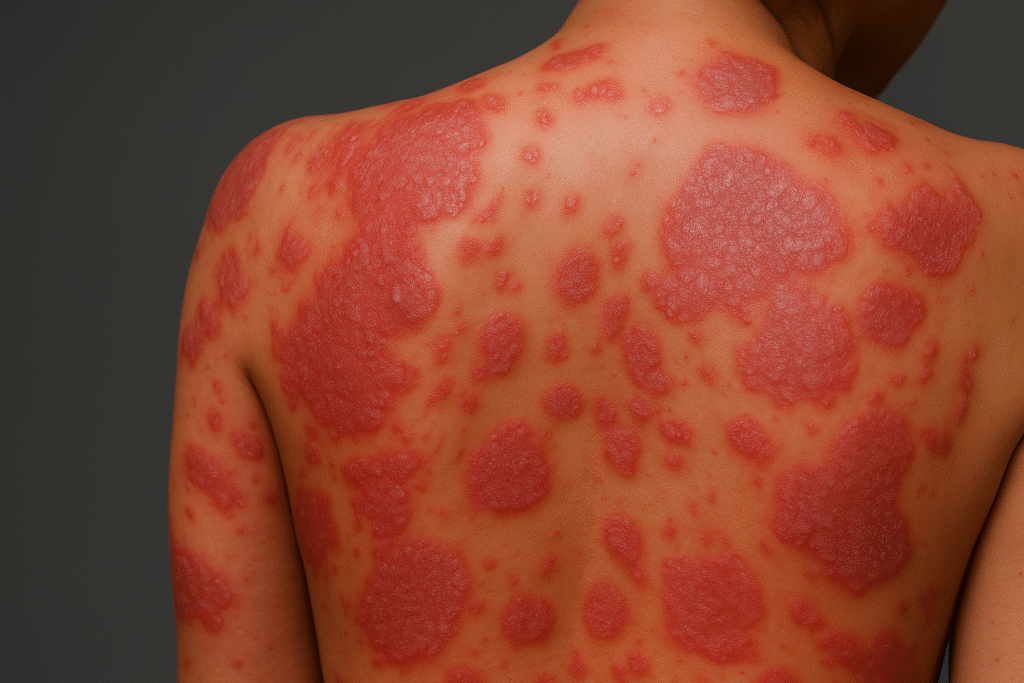Navigating the complexities of government benefits is never easy, especially when health issues are involved. For those living with generalized postural psoriasis, the physical discomfort and limitations can significantly disrupt everyday life. Many ask, “Can generalized postural psoriasis be a reason for SSI benefits?” This question arises from a very real concern: coping with a chronic condition that not only affects the skin but deeply impacts mobility, quality of life, and the ability to work.
This article aims to demystify the eligibility of generalized postural psoriasis for Supplemental Security Income (SSI), guiding you through the criteria, documentation process, and practical advice on applying. We will discuss how the Social Security Administration (SSA) evaluates this condition, what kind of medical evidence is needed, and how to strengthen your case.
Generalized postural psoriasis is a severe and rare form of psoriasis where widespread red, scaly patches can affect various postural areas like the back, shoulders, buttocks, and hips. Unlike milder forms, this variant often causes significant pain, itching, cracking, and even open sores. The persistent inflammation can severely hinder daily activities such as sitting, walking, or even sleeping properly.
This condition may not only cause physical impairment but also mental distress, including anxiety and depression due to the chronic nature and appearance of the skin. While psoriasis is often dismissed as a “skin condition,” the postural aspect introduces mobility issues, sometimes comparable to musculoskeletal or neurological impairments.
Can Generalized Postural Psoriasis Be a Reason for SSI Benefits?
Yes, generalized postural psoriasis can be a valid reason to apply for SSI benefits, provided it meets certain medical and financial criteria. SSI is a need-based program managed by the SSA that offers monthly payments to individuals who are aged, blind, or disabled, and have limited income and resources. For psoriasis to be recognized as a disabling condition under SSI, it must substantially limit your ability to perform basic work activities.
The SSA evaluates psoriasis under Listing 8.05 (dermatological disorders). To meet the criteria, applicants must show that the disease:
-
Persists despite prescribed treatment
-
Results in extensive skin lesions across major body areas
-
Causes marked limitation in daily functioning or mobility
-
Requires continuous medication or therapy with side effects
When psoriasis severely limits postural ability, especially in generalized forms, it aligns closely with other disabling musculoskeletal or autoimmune conditions, increasing the chance of SSI approval.
Medical Evidence Required to Qualify for SSI with Psoriasis
To prove that generalized postural psoriasis qualifies as a disability, comprehensive medical documentation is vital. SSA examiners look for:
-
Diagnosis by a board-certified dermatologist
-
Treatment records spanning at least 12 months
-
Skin biopsy or imaging results (if applicable)
-
Photos showing the affected areas
-
Functional limitation reports from healthcare providers
-
List of medications and side effects
-
Statements from occupational therapists or physiotherapists regarding limited mobility
Keeping a symptom journal and consistent medical records increases your credibility. SSA may also send you to a consultative examination (CE) to further assess your limitations.
How Postural Limitations Influence SSI Eligibility
Postural limitations, when caused by widespread skin irritation, inflammation, or open wounds, significantly affect the ability to sit, stand, or move comfortably for extended periods. This is crucial because most jobs—whether sedentary or active—require some level of postural endurance.
If generalized postural psoriasis leads to:
-
Difficulty standing or sitting for more than 2 hours
-
Chronic pain requiring regular medication
-
Inability to perform tasks requiring repeated movement
-
Psychological impact such as anxiety or social withdrawal
Then it becomes more than a skin condition; it becomes a disability under the SSA’s framework.
Financial Eligibility for SSI
Unlike SSDI, which is based on work credits, SSI eligibility depends on your income and resources. In 2025, to qualify:
-
Your income must be under $943/month for individuals or $1,415 for couples
-
Countable assets must not exceed $2,000 for individuals or $3,000 for couples
This includes bank accounts, cash, and investments but excludes your primary residence and vehicle. You’ll need to supply bank statements, rent receipts, and any other financial documentation during the application.
The Role of RFC in SSI Approval
SSA may not approve your claim based on listing 8.05 alone. In such cases, the SSA will assess your Residual Functional Capacity (RFC)—essentially how much work you can still perform. An RFC takes into account:
-
Physical limitations: Can you lift, stand, walk, or sit?
-
Mental health: Depression, anxiety, or stress levels due to the condition
-
Consistency: Do flare-ups make your condition unpredictable?
A lower RFC score boosts your chances for SSI approval, particularly if your doctor fills out a detailed RFC form on your behalf.
How Mental Health Ties Into SSI Eligibility
Living with a disfiguring and painful condition like generalized postural psoriasis often brings psychological tolls—low self-esteem, isolation, or major depressive disorder. If your condition includes mental impairments, SSA may assess your claim under Listing 12.04 or 12.06, for depressive or anxiety disorders respectively.
Psychological evaluations, therapy notes, and psychiatric medications also count as supporting medical evidence for your case.
Tips for a Strong SSI Application
Here’s what you can do to improve your odds:
-
Consult an attorney or disability advocate
-
Gather at least 12 months of medical records
-
Ask your doctor to write a narrative explaining your condition
-
Include photos, journal logs, and symptom diaries
-
Be honest and consistent in your functionality reports
-
Follow through with all SSA-requested exams
What to Do If Your Claim Is Denied
Unfortunately, many first-time SSI applications are denied due to insufficient evidence or technical errors. If this happens:
-
File a Request for Reconsideration within 60 days
-
Present additional evidence or medical records
-
Attend all scheduled hearings or consultative exams
-
Seek legal support from a disability lawyer
Success rates significantly increase during the appeal process, especially when legal counsel is involved.
SSI for Children with Generalized Postural Psoriasis
Children are also eligible for SSI if their condition causes marked and severe functional limitations. Evidence should show that psoriasis limits:
-
Developmental milestones
-
School attendance or performance
-
Daily activities like dressing, hygiene, or mobility
A pediatrician’s testimony, school reports, and caregiver diaries can be crucial for child SSI cases.
How Long Does It Take to Get SSI for Psoriasis?
Processing an SSI claim can take 3 to 6 months or more. Factors include:
-
Completeness of your application
-
Medical evidence availability
-
Backlog at your local SSA office
Providing complete, organized documentation can accelerate the process.
Can You Work While Receiving SSI for Psoriasis?
Yes, but your earnings must stay under the SSI income limits. You can also explore the SSA’s Ticket to Work program, which encourages individuals with disabilities to return to employment without immediate loss of benefits.
Is a Skin Disease Really Considered a Disability?
Absolutely. When chronic, painful, and limiting, skin disorders—especially generalized variants—can significantly impair physical and mental functioning. SSA recognizes this through various listing categories and RFC analysis.
Also read: Linea Alba Cheek: Causes, Diagnosis, and Long-Term Management
FAQs
Can generalized postural psoriasis qualify as a disability for SSI?
Yes, if it significantly impairs your ability to perform work-related activities and meets SSA’s medical and financial criteria.
What kind of evidence do I need?
Detailed medical records, images of affected areas, functional reports, prescription history, and possibly mental health evaluations.
How long must I have had psoriasis before applying?
The SSA prefers a documented history of 12 months or a prognosis that your condition will last at least 12 months or result in death.
Can mental health symptoms related to psoriasis help my case?
Yes, associated mental health conditions like anxiety or depression can strengthen your claim under additional SSA listings.
Will having a job disqualify me?
Not necessarily. You can earn limited income while still qualifying for SSI if your condition significantly limits your work capacity.
Can children get SSI for psoriasis?
Yes, if it severely limits their daily functioning and is supported by medical and educational documentation.
Conclusion
Generalized postural psoriasis is more than just a skin condition—it can be debilitating, painful, and emotionally draining. Fortunately, for those who qualify, SSI benefits can provide crucial financial support to ease the burden of living with this chronic illness. While the road to approval may seem daunting, preparation, documentation, and persistence are key. Always consult healthcare and legal professionals to strengthen your application and ensure you get the support you rightfully deserve.


